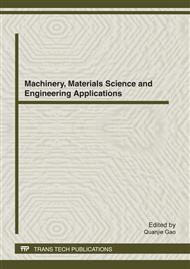p.753
p.757
p.762
p.768
p.772
p.776
p.781
p.786
p.790
Research on Key Technology of Normal Grain Growth for Second Phase Particle Materials by Cellular Automata Simulation
Abstract:
Based on cellular automata, a model of simulating grain growth was established and the key technologies of simulation was studied which including second phase particle of single size, multi-size distribution and different shapes generation technologies. The simulation result can accurately reflect the influence law of the second phase particle grain growth and its pinning mechanism. Grain boundaries can therefore more easily break free from the particles than in purely two-dimensional systems, resulting in fewer grain boundaryparticle intersections and a larger final grain size. For a given volume fraction f and size of the particles r, the final grain size increases with film thickness. Moreover, it was found that particles located in the middle of the film are most efficient in pinning grain boundaries. The simulation results are compared with Zener type relations and previous simulation results.
Info:
Periodical:
Pages:
772-775
Citation:
Online since:
April 2012
Authors:
Keywords:
Price:
Сopyright:
© 2012 Trans Tech Publications Ltd. All Rights Reserved
Share:
Citation:


